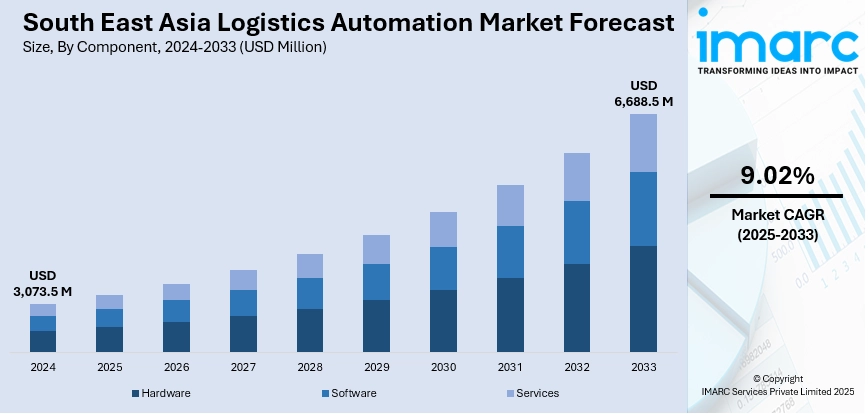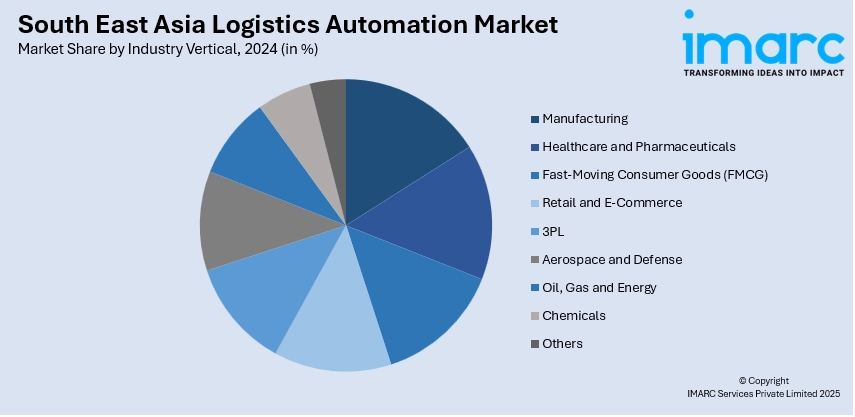
South East Asia Logistics Automation Market Size, Share, Trends and Forecast by Component, Function, Enterprise Size, Industry Vertical, and Country, 2025-2033
Market Overview:
South East Asia logistics automation market size reached USD 3,073.5 Million in 2024. Looking forward, IMARC Group expects the market to reach USD 6,688.5 Million by 2033, exhibiting a growth rate (CAGR) of 9.02% during 2025-2033. The increasing demand for automated systems, which can optimize routes, reduce fuel consumption, and minimize errors, leading to overall operational cost savings, is driving the market.
|
Report Attribute
|
Key Statistics
|
|---|---|
|
Base Year
|
2024 |
|
Forecast Years
|
2025-2033
|
|
Historical Years
|
2019-2024
|
| Market Size in 2024 | USD 3,073.5 Million |
| Market Forecast in 2033 | USD 6,688.5 Million |
| Market Growth Rate (2025-2033) | 9.02% |
Logistics automation refers to the application of technology and software solutions to streamline and optimize various processes within the supply chain and logistics management. It involves the use of advanced technologies such as artificial intelligence, machine learning, robotics, and data analytics to enhance the efficiency, accuracy, and speed of tasks related to inventory management, order processing, transportation, and warehouse operations. By automating repetitive and time-consuming tasks, logistics automation helps businesses reduce operational costs, minimize errors, and improve overall productivity. It also enables real-time tracking and visibility of goods in transit, enhances decision-making processes, and facilitates better coordination among various components of the supply chain. Ultimately, logistics automation plays a pivotal role in modernizing and revolutionizing traditional logistics practices, contributing to a more agile and responsive supply chain in the rapidly evolving business landscape.

To get more information on this market, Request Sample
South East Asia Logistics Automation Market Trends:
The logistics automation market in South East Asia is propelled by several key drivers. Firstly, the exponential growth of e-commerce is a primary catalyst, necessitating streamlined and efficient logistics processes. As online retail continues to surge, companies are increasingly turning to automation solutions to meet the escalating demands for quick and accurate order fulfillment. Moreover, the advent of advanced technologies such as artificial intelligence (AI) and the Internet of Things (IoT) has significantly impacted the logistics automation landscape. These cutting-edge technologies enable real-time monitoring, predictive analytics, and intelligent decision-making, thereby enhancing overall supply chain visibility and efficiency. In addition, the ongoing regional focus on sustainability is driving the adoption of green logistics practices, with automation playing a pivotal role in optimizing routes, reducing fuel consumption, and minimizing environmental impact. Furthermore, the pressing need for cost reduction and operational optimization is steering businesses towards logistics automation solutions. Automated warehouses, autonomous vehicles, and robotic systems offer not only increased operational efficiency but also substantial cost savings in the long run. As industries recognize the multifaceted benefits of logistics automation, from enhanced speed and accuracy to reduced operational costs and environmental impact, the regional market is poised for continued expansion.
South East Asia Logistics Automation Market Segmentation:
IMARC Group provides an analysis of the key trends in each segment of the market, along with forecasts at the regional and country level for 2025-2033. Our report has categorized the market based on component, function, enterprise size, and industry vertical.
Component Insights:
- Hardware
- Mobile Robots (AGV, AMR)
- Automated Storage and Retrieval Systems (AS/RS)
- Automated Sorting Systems
- De-Palletizing/Palletizing Systems
- Conveyor Systems
- Automatic Identification and Data Collection (AIDC)
- Order Picking
- Software
- Warehouse Management Systems (WMS)
- Warehouse Execution Systems (WES)
- Services
- Value Added Services
- Maintenance
The report has provided a detailed breakup and analysis of the market based on the component. This includes hardware (mobile robots (AGV, AMR), automated storage and retrieval systems (AS/RS), automated sorting systems, de-palletizing/palletizing systems, conveyor systems, automatic identification and data collection (AIDC), and order picking), software (warehouse management systems (WMS) and warehouse execution systems (WES)), and services (value added services and maintenance).
Function Insights:
- Warehouse and Storage Management
- Transportation Management
A detailed breakup and analysis of the market based on function have also been provided in the report. This includes warehouse and storage management and transportation management.
Enterprise Size Insights:
- Small and Medium-sized Enterprises
- Large Enterprises
The report has provided a detailed breakup and analysis of the market based on the enterprise size. This includes small and medium-sized enterprises and large enterprises.
Industry Vertical Insights:

- Manufacturing
- Healthcare and Pharmaceuticals
- Fast-Moving Consumer Goods (FMCG)
- Retail and E-Commerce
- 3PL
- Aerospace and Defense
- Oil, Gas and Energy
- Chemicals
- Others
A detailed breakup and analysis of the market based on industry vertical have also been provided in the report. This includes manufacturing, healthcare and pharmaceuticals, fast-moving consumer goods (FMCG), retail and E-commerce, 3PL, aerospace and defense, oil, gas and energy, chemicals, and others.
Country Insights:
- Indonesia
- Thailand
- Singapore
- Philippines
- Vietnam
- Malaysia
- Others
The report has also provided a comprehensive analysis of all the major regional markets, which include Indonesia, Thailand, Singapore, Philippines, Vietnam, Malaysia, and Others.
Competitive Landscape:
The market research report has also provided a comprehensive analysis of the competitive landscape in the market. Competitive analysis such as market structure, key player positioning, top winning strategies, competitive dashboard, and company evaluation quadrant has been covered in the report. Also, detailed profiles of all major companies have been provided.
South East Asia Logistics Automation Market Report Coverage:
| Report Features | Details |
|---|---|
| Base Year of the Analysis | 2024 |
| Historical Period | 2019-2024 |
| Forecast Period | 2025-2033 |
| Units | Million USD |
| Scope of the Report | Exploration of Historical and Forecast Trends, Industry Catalysts and Challenges, Segment-Wise Historical and Predictive Market Assessment:
|
| Components Covered |
|
| Functions Covered | Warehouse and Storage Management, Transportation Management |
| Enterprise Sizes Covered | Small and Medium-sized Enterprises, Large Enterprises |
| Industry Verticals Covered | Manufacturing, Healthcare and Pharmaceuticals, Fast-Moving Consumer Goods (FMCG), Retail and E-Commerce, 3PL, Aerospace and Defense, Oil, Gas and Energy, Chemicals, Others |
| Countries Covered | Indonesia, Thailand, Singapore, Philippines, Vietnam, Malaysia, Others |
| Customization Scope | 10% Free Customization |
| Post-Sale Analyst Support | 10-12 Weeks |
| Delivery Format | PDF and Excel through Email (We can also provide the editable version of the report in PPT/Word format on special request) |
Key Questions Answered in This Report:
- How has the South East Asia logistics automation market performed so far and how will it perform in the coming years?
- What has been the impact of COVID-19 on the South East Asia logistics automation market?
- What is the breakup of the South East Asia logistics automation market on the basis of component?
- What is the breakup of the South East Asia logistics automation market on the basis of function?
- What is the breakup of the South East Asia logistics automation market on the basis of enterprise size?
- What is the breakup of the South East Asia logistics automation market on the basis of industry vertical?
- What are the various stages in the value chain of the South East Asia logistics automation market?
- What are the key driving factors and challenges in the South East Asia logistics automation?
- What is the structure of the South East Asia logistics automation market and who are the key players?
- What is the degree of competition in the South East Asia logistics automation market?
Key Benefits for Stakeholders:
- IMARC’s industry report offers a comprehensive quantitative analysis of various market segments, historical and current market trends, market forecasts, and dynamics of the South East Asia logistics automation market from 2019-2033.
- The research report provides the latest information on the market drivers, challenges, and opportunities in the South East Asia logistics automation market.
- Porter's five forces analysis assist stakeholders in assessing the impact of new entrants, competitive rivalry, supplier power, buyer power, and the threat of substitution. It helps stakeholders to analyze the level of competition within the South East Asia logistics automation industry and its attractiveness.
- Competitive landscape allows stakeholders to understand their competitive environment and provides an insight into the current positions of key players in the market.
Need more help?
- Speak to our experienced analysts for insights on the current market scenarios.
- Include additional segments and countries to customize the report as per your requirement.
- Gain an unparalleled competitive advantage in your domain by understanding how to utilize the report and positively impacting your operations and revenue.
- For further assistance, please connect with our analysts.
 Request Customization
Request Customization
 Speak to an Analyst
Speak to an Analyst
 Request Brochure
Request Brochure
 Inquire Before Buying
Inquire Before Buying




.webp)




.webp)












